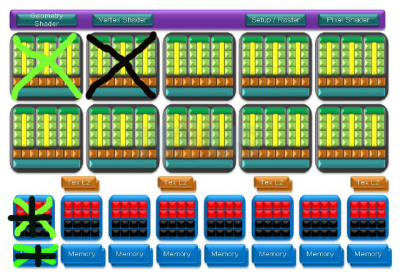What's new?
What's changed is the shader count, from 192 to 216. Let's grab the block diagram to explain.
An inordinate amount of expense was incurred on modifying the GeForce GTX 280 block diagram to fit the GTX 260s (ahem!!).
Simplifying it somewhat, NVIDIA's GT200 design calls for clusters that each house 24 stream processors. GTX 280 has 10 such clusters, making up 240 stream processors. Present GTX 260 uses eight, meaning 192 SPs.
Now, the all-new GTX 260 uses, well, nine, and that's why the total count could not have been anything other than 216 if performance was to be improved over the incumbent.
As the texture-address and filter units are tied in with the clusters, the GTX 260 (216) now can sample and bilinear-filter 72ppc, rather than 64ppc on the old GPU.
The green cross indicates what's removed for new GTX 260 and the black represents the additional lop-off for present 260. What this means, as per the table, is that new GTX 260 has more shading and texturing power than old GTX 260.
The bottom-end is the same, however, with seven ROP partitions (28 in total) and a removal of one 64-bit memory channel, bringing GPU-wide bandwidth to 448 bits - or the same as GTX 260 (old).
NVIDIA will transition all GTX-series cards to a 55nm manufacturing process at some point this year, we believe, and GTX 260 (new) will be one of the first recipients.
Nomenclature
We'd have much preferred matters if NVIDIA had named the new GPU something like GeForce GTX 270. By doing so, purchasers would have a better idea on what they were buying, rather than attempt to differentiate between two SKUs based on the stream-processor count.
We can imagine a month or two of consternation when the changeover between GTX 260s takes place and whilst we laud consistency, it makes no real sense here, unless 192SP GTX 260 can be phased out very, very quickly.
Pragmatically speaking, it appears as if NVIDIA's yields have improved enough to warrant a greater number of nine-cluster GPUs, and that's why, we suppose, GTX 260 rev. 216 has been brought to the market.
We expect stock-clocked cards to etail at around £199, with partner-overclocked models available for £225 or so.
Summary
The new GeForce GTX 260 simply adds in one extra processing cluster - 24 stream processors - to the present '260, bringing up the count to 216. Shading performance is up, as is texturing, but there's no change to memory bandwidth.
The new SKU helps to bridge the gap that exists between the two current members of the GT200 family, and it arrives with a slightly higher street price.
A confusing aspect will be how board partners market the card, because it carries the same name as the present model: a headache, for sure.
Speaking of partners, we received a BFG 'MAXCORE' card in at the last moment...










